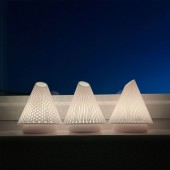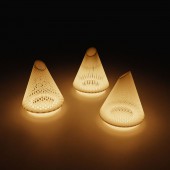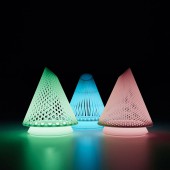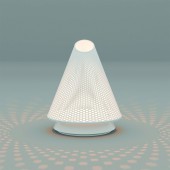
| THE AWARD |
| CATEGORIES |
| REGISTRATION |
| SUBMIT YOUR WORK |
| ENTRY INSTRUCTIONS |
| TERMS & CONDITIONS |
| PUBLICATIONS |
| DATES & FEES |
| METHODOLOGY |
| CONTACT |
| WINNERS |
| PRESS ROOM |
| GET INVOLVED |
| DESIGN PRIZE |
| DESIGN STORE |
| THE AWARD | JURY | CATEGORIES | REGISTRATION | PRESS | WINNERS | PUBLICATIONS | ENTRY INSTRUCTIONS |
Conequeror Lamp by Kezia Age |
Home > Winners > Design #155720 >Interview |
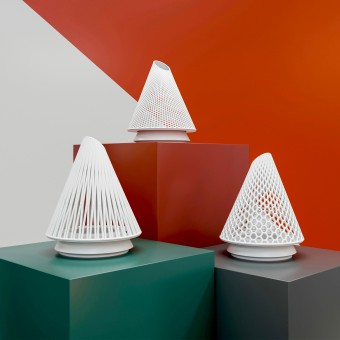 |
|
FS: What is the main principle, idea and inspiration behind your design?
KS: The Conqueror Lamp was designed to redefine the essence of the primitive in a contemporary context. The aim of this project was to translate the dark side perception of primitive nature into a warm, minimalist, 3D-printed conical shape. This lamp draws inspiration from primitive life and Mbaru Niang, one of the traditional houses of Indonesia. Mbaru Niang epitomizes architectural structures featuring conical houses constructed from natural materials such as woven rattan, bamboo, and wood. This conical shape is then redefined by a parametric approach, symbolizing primitive nature and encapsulating a synthesis of tradition and contemporary ingenuity.
FS: What has been your main focus in designing this work? Especially what did you want to achieve?
KS: The main focus of this design is to redefine the essence of the primitive in a contemporary context. Today’s society often perceives primitive culture negatively, associating it with cannibalism and fear. This lamp aims to challenge these perceptions by demonstrating that what might seem dark or unsettling to outsiders actually embodies calmness and security within the context of primitive societies. The Conequeror Lamp seeks to highlight how these elements were integral to creating a sense of community and safety for their clans.
FS: What are your future plans for this award winning design?
KS: My plan for this design is to sell and multiply it, potentially producing smaller versions to reach a larger market.
FS: How long did it take you to design this particular concept?
KS: This design takes approximately three months, from the initial concept to realization.
FS: Why did you design this particular concept? Was this design commissioned or did you decide to pursuit an inspiration?
KS: I designed this particular concept to redefine the essence of the primitive in a contemporary context and challenge the negative perceptions often associated with primitive culture. Starting from my master's degree final project, I decided to pursue this inspiration independently, driven by a desire to showcase how elements viewed as dark or unsettling can actually symbolize calmness and security within primitive societies.
FS: Is your design being produced or used by another company, or do you plan to sell or lease the production rights or do you intent to produce your work yourself?
KS: This design is not currently produced by any other company. I am planning to produce it commercially, aiming to bring this unique concept to a broader market. By taking on the production or lease the production right by still ensuring the design's integrity and quality, making sure it aligns with the original concept.
FS: What made you design this particular type of work?
KS: I designed this particular type of work to showcase the beauty of primitive nature, which is often viewed negatively in society. By highlighting the intricate and harmonious aspects of primitive design, I aim to change the perception that these cultures are merely dark or frightening. My goal is to celebrate and elevate the essence of primitive culture in a contemporary context, demonstrating its relevance and appeal in modern design.
FS: Where there any other designs and/or designers that helped the influence the design of your work?
KS: Certainly, the Louvre Abu Dhabi, designed by Ateliers Jean Nouvel, influenced my work. Its fusion of traditional architectural elements with contemporary design principles inspired me to approach my own design with a similar balance. I aimed to capture the essence of primitive culture in a modern context, echoing the Louvre Abu Dhabi's celebration of heritage while appealing to contemporary sensibilities.
FS: Who is the target customer for his design?
KS: The target customer for this design is broad, encompassing a wide range of modern individuals. By embodying contemporary aesthetics while retaining cultural depth, this design appeals to a diverse audience. Its versatility makes it suitable for anyone seeking innovative and visually striking pieces that resonate with both tradition and modernity.
FS: What sets this design apart from other similar or resembling concepts?
KS: What sets this design apart from other concepts is its unique fusion of traditional, primitive themes with modern technology. While other designs may focus solely on either traditional craftsmanship or modern aesthetics, this design seamlessly blends the two, creating a harmonious synthesis of primitive nature and contemporary style. Additionally, the portability of the lamp design adds another dimension of functionality and convenience not often found in similar concepts.
FS: How did you come up with the name for this design? What does it mean?
KS: The name "Conequeror" was born out of a fusion of ideas. It combines "cone," representing a geometric shape found in the Mbaru Niang conical house, which symbolizes both resilience and harmony, with "conqueror," denoting victory or mastery over challenges. This name was inspired by the capability of primitive society to overcome various obstacles like the sea, jungle, and darkness.
FS: Which design tools did you use when you were working on this project?
KS: When working on this project, I utilized various design tools to bring the concept to life. Specifically, I relied on 3D modeling software to create prototypes of the design.
FS: What is the most unique aspect of your design?
KS: The most unique aspect of this design is its fusion of parametric design with cutting-edge LED technology. This allows the lamp to emit a modern glow in 13 different colors and project three patterns, offering a versatile and emotional experience. Additionally, its portability creates a protective atmosphere wherever it's placed, transforming any space into a tranquil haven.
FS: Who did you collaborate with for this design? Did you work with people with technical / specialized skills?
KS: For this design, I collaborated with a lecturer from my university who possessed technical and specialized skills relevant to the project. Their expertise helped in refining the technical aspects of the design, particularly in areas such as parametric design and LED technology integration. Additionally, working with someone from an academic background provided a fresh perspective and facilitated the exploration of innovative design solutions.
FS: What is the role of technology in this particular design?
KS: Technology plays a crucial role in this design by translating the abstract concepts of darkness, primitivity, and emotion into tangible elements within a contemporary context. Through techniques like parametric design and LED technology, the design captures the essence of primitive culture while offering customizable lighting experiences that evoke specific moods and atmospheres.
FS: Is your design influenced by data or analytical research in any way? What kind of research did you conduct for making this design?
KS: Yes, this design was influenced by both data and analytical research. Prior to developing the design concept, I conducted extensive research into primitive cultures, traditional architectural structures, and contemporary design trends. This research involved studying historical texts, cultural artifacts, and architectural blueprints to gain a deeper understanding of the themes and elements I wanted to incorporate into the design. Additionally, I conducted market research to identify consumer preferences, emerging trends, and technological advancements relevant to the design.
FS: What are some of the challenges you faced during the design/realization of your concept?
KS: One of the main challenges was ensuring cost-effective production while maintaining the design's integrity. This involved finding suitable manufacturing processes, sourcing affordable materials, and optimizing logistics for distribution.
FS: How did you decide to submit your design to an international design competition?
KS: I decided to submit my design to an international design competition as a platform to showcase my perspective and creative vision to a global audience. By participating in such competition, I saw an opportunity to share my innovative approach and contribute to the broader discourse within the design community. Additionally, I viewed the competition as a chance to receive valuable feedback from industry experts and peers, helping me refine and improve my design skills further.
FS: What did you learn or how did you improve yourself during the designing of this work?
KS: Throughout the design process, I underwent significant personal growth as I delved deeper into the essence of primitive culture. This exploration led me to a profound appreciation for the values of tranquility, balance, and togetherness that underpin primitive societies. Importantly, I internalized the lesson of not judging individuals solely based on their physical appearance, but rather seeking to understand the deeper essence of each person and culture. This realization sparked a fundamental shift in my perspective, fostering empathy, open-mindedness, and cultural sensitivity in both my design approach and broader worldview.
FS: Any other things you would like to cover that have not been covered in these questions?
KS: One aspect worth mentioning is the transformative power of design in shaping perspectives and driving social change. Design has the ability to challenge stereotypes, break down barriers, and promote inclusivity and diversity. Through thoughtful and innovative design, we can create spaces, products, and experiences that challenge societal norms and encourage empathy and understanding. Design can serve as a catalyst for social justice by amplifying marginalized voices, advocating for equality, and addressing pressing social issues.
FS: Thank you for providing us with this opportunity to interview you.
A' Design Award and Competitions grants rights to press members and bloggers to use parts of this interview. This interview is provided as it is; DesignPRWire and A' Design Award and Competitions cannot be held responsible for the answers given by participating designers.
| SOCIAL |
| + Add to Likes / Favorites | Send to My Email | Comment | View Press-Release |

